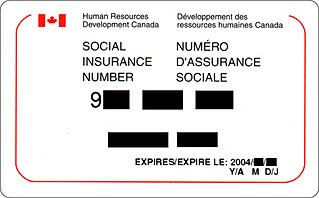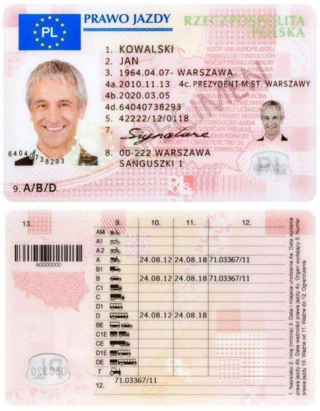Related Research Articles
An identity document is any document that may be used to prove a person's identity. If issued in a small, standard credit card size form, it is usually called an identity card, or passport card. Some countries issue formal identity documents, as national identification cards that may be compulsory or non-compulsory, while others may require identity verification using regional identification or informal documents. When the identity document incorporates a person's photograph, it may be called photo ID.

A social insurance number (SIN) (French: numéro d'assurance sociale (NAS)) is a number issued in Canada to administer various government programs. The SIN was created in 1964 to serve as a client account number in the administration of the Canada Pension Plan and Canada's varied employment insurance programs. In 1967, Revenue Canada (now the Canada Revenue Agency) started using the SIN for tax reporting purposes. SINs are issued by Employment and Social Development Canada (previously Human Resources Development Canada).
Saskatchewan Government Insurance (SGI) is a Canadian insurance company and a Crown corporation wholly owned by the Government of Saskatchewan. SGI's operations consist of the Saskatchewan Auto Fund, the compulsory public auto insurance program for Saskatchewan, and its property and casualty insurance division sells additional automobile and property insurance products in five Canadian provinces under the trade name SGI Canada.

Transgender rights in Canada, including procedures for changing legal gender and protections from discrimination, vary among provinces and territories, due to Canada's nature as a federal state. According to the 2021 Canadian census, 59,460 Canadians identify as transgender.

The Canadian Automobile Association is a federation of eight regional not-for-profit automobile associations in Canada, founded in 1913. The constituent associations are responsible for providing roadside assistance, auto touring and leisure travel services, insurance services, and member discount programs within their service territories. The CAA National Office in Ottawa coordinates relations between the clubs, oversees joint initiatives, and lobbies the federal government. In 2020 and 2021, the Gustavson Brand Trust Index named CAA the most trusted brand in Canada.

Photo identification or photo ID is an identity document that includes a photograph of the holder, usually only their face. The most commonly accepted forms of photo ID are those issued by government authorities, such as driver's licenses, identity cards and passports, but special-purpose photo IDs may be also produced, such as internal security or access control cards.

The Insurance Corporation of British Columbia (ICBC) is a provincial Crown corporation in British Columbia providing insurance. ICBC was created in 1973 by the NDP government of Premier Dave Barrett.
Crown corporations in Canada are government organizations with a mixture of commercial and public-policy objectives. They are directly and wholly owned by the Crown.

In the United States, driver's licenses are issued by each individual state, territory, and the District of Columbia rather than by the federal government due to federalism. Drivers are normally required to obtain a license from their state of residence. All states of the United States and provinces and territories of Canada recognize each other's licenses for non-resident age requirements. There are also licenses for motorcycle use. Generally, a minimum age of 16 is required to apply for a non-commercial driver's license, and 18 for commercial licenses which drivers must have to operate vehicles that are too heavy for a non-commercial licensed driver or vehicles with at least 16 passengers or containing hazardous materials that require placards. A state may also suspend an individual's driving privilege within its borders for traffic violations. Many states share a common system of license classes, with some exceptions, e.g. commercial license classes are standardized by federal regulation at 49 CFR 383. Many driving permits and ID cards display small digits next to each data field. This is required by the American Association of Motor Vehicle Administrators' design standard and has been adopted by many US states. According to the United States Department of Transportation, as of 2018, there are approximately 227 million licensed drivers in the United States.

In Canada, driver's licences are issued by the government of the province or territory in which the driver is residing. Thus, specific regulations relating to driver's licences vary province to province, though overall they are quite similar. All provinces have provisions allowing non-residents to use licences issued by other provinces and territories, out-of-country licences, and International Driving Permits. Many provinces also allow non-residents to use regular licences issued by other nations and countries. Canadian driver's licences are also valid in many other countries due to various international agreements and treaties.
Public auto insurance is a government-owned and -operated system of compulsory automobile insurance used in the Canadian provinces of British Columbia, Saskatchewan, Manitoba, and Quebec. It is based on the idea that if motorists are compelled to purchase auto insurance by the government, the government ought to ensure motorists pay fair premiums and receive high-quality coverage. Governments across the country have used various insurance schemes from full tort to full no-fault in pursuit of that goal.
Vehicle registration plates of Canada, also known as license plates, are issued by provincial or territorial government agencies. Registration plates in Canada are typically attached to motor vehicles or trailers for official identification purposes. Some Canadian registration plates have unique designs, shapes, and slogans related to the issuing jurisdiction. For example, registration plates issued in the Northwest Territories are shaped like a polar bear. In Alberta, registration plates typically display the words "Wild Rose Country."
In the United States, a cityidentification card is a form of identification card issued by a municipality, such as a city, rather than a state or federal government. Under federal law, cities may issue their own identification cards as they see fit, and do not have to consider the immigration or criminal status of an applicant before doing so. New Haven, Connecticut issued the first municipal identification cards in the United States, the Elm City Resident Card, in 2007. On January 15, 2009, the city/county of San Francisco launched the SF City ID Card, a municipal identification card program modeled after New Haven's. Other cities that issue identification cards include Asbury Park, New Jersey, and Washington, D.C.. In Mercer County, New Jersey, a community ID card is being issued by a local non profit organization with the endorsement of various law enforcement agencies.

A voter identification law is a law that requires a person to show some form of identification in order to vote. In some jurisdictions requiring photo IDs, voters who do not have photo ID often must have their identity verified by someone else or sign a Challenged Voter Affidavit in order to receive a ballot to vote.
Liquor-control agencies in some Canadian provinces have produced age-of-majority ID cards to facilitate the purchase of alcohol by Canadian adults. Only one still produces these cards, although their acceptability is limited and their purpose has been mostly supplanted by other forms of ID, such as provincial photo cards for non-drivers.
An enhanced driver's licence or enhanced ID in common usage, is a card which functions both as driving licence and identity card with limited passport features issued in some provinces in Canada, in some states in the United States, for people who are both citizens of the country and residents of the relevant region, compliant with the Western Hemisphere Travel Initiative.

A driver's license or driving permit is a legal authorization, or the official document confirming such an authorization, for a specific individual to operate one or more types of motorized vehicles—such as motorcycles, cars, trucks, or buses—on a public road. Such licenses are often plastic and the size of a credit card.
Obligation of identification describes the requirement to be in possession of a valid identity card and to produce this on demand when requested by authorities.
Australian state and territory issued identity photo cards are photo identification cards issued by the States and Territories of Australia. While the drivers license is similar to the photo identity card, the photo identity card is treated separately here.
Australia does not have a national identity card. Instead, various documents may be used or required to prove a person's identity, whether for government or commercial purposes such as:
References
- 1 2 "Get an ID card". www.alberta.ca. Retrieved 2020-11-18.
- ↑ "Apply for a BCID". www.icbc.com. Retrieved 2021-11-23.
- 1 2 "Fees – Driver licensing". Insurance Corporation of British Columbia. Retrieved 2015-03-31.
- ↑ "How to apply for an identification card". www.mpi.mb.ca. Retrieved 2021-11-23.
- ↑ "Making changes to your identification card". www.mpi.mb.ca. Retrieved 2021-11-23.
- ↑ Government of New Brunswick, Canada (2006-03-14). "Photo ID Card". www2.gnb.ca. Retrieved 2021-11-23.
- ↑ "Driver Fees" (PDF). Archived (PDF) from the original on 2021-09-14.
- ↑ "Photo ID". Digital Government and Service NL. Retrieved 2021-11-23.
- ↑ "Nova Scotia Permits Directory - Registry of Motor Vehicles - ID Cards (Photo)". novascotia.ca. Retrieved 2021-11-23.
- ↑ "Ontario Photo Card". ontario.ca. Retrieved 2021-11-23.
- ↑ Toolkit, Web Experience (2017-11-17). "Photographic Identification Card (Voluntary ID)". www.princeedwardisland.ca. Retrieved 2021-11-23.
- ↑ SGI. "Photo ID". SGI. Retrieved 2021-11-23.
- ↑ "Apply for EDL, EIC or BCID". www.icbc.com. Archived from the original on 2014-05-16.
- ↑ "ICBC | B.C.'s enhanced identification card". www.icbc.com. Archived from the original on 2009-05-19.
- ↑ "Manitoba Public Insurance | Manitoba Enhanced Driver's Licence and Enhanced Identification Card Program | Applicant's Guide | What is the Manitoba EIC?". Archived from the original on 2012-06-18. Retrieved 2012-05-18.
- ↑ "Photo ID Card". gnb.ca. 14 March 2006.
- ↑ "Welcome to Digital Government and Service NL".
- ↑ "Newsroom : Ontario Introduces New Photo ID Card". news.ontario.ca.
- 1 2 "Photo card expanding to more service centres". northernlife.ca.
- ↑ "Guide 0505 Documents: Identification Card - PEI Association for Newcomers to Canada". peianc.com. Archived from the original on 2012-03-05. Retrieved 2012-05-18.
- ↑ SGI. "SGI - Get photo ID". sgi.sk.ca/.
- ↑ "New DL and GIC". Archived from the original on 2012-05-31. Retrieved 2012-05-18.
- ↑ "Archived copy" (PDF). Archived from the original (PDF) on 2011-12-18. Retrieved 2012-05-18.
{{cite web}}: CS1 maint: archived copy as title (link) - ↑ "Government flashes new drivers' licences - Yukon News". yukon-news.com.
- ↑ "Secure Driver's Licence & General Identification Card". gov.yk.ca. 19 November 2021.